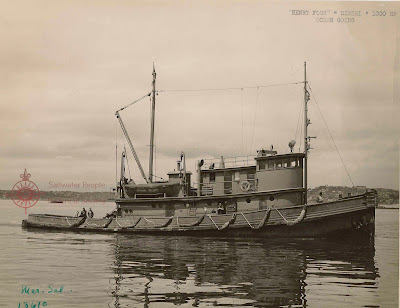 |
| Halibut steamer SAN JUAN San Juan Fish and Packing Co, Seattle, WA. Original photo from the archives of the S.P.H.S.© |
The smoke boats, as fishing vessels propelled by steam were called, were years ago crowded off the banks by the more efficient and less expensive diesel-powered schooners which now comprise the halibut fleet.
Down at the Deep Sea Fishermen's Union Hall, veterans of smoke boat days in the North Pacific were telling about experiences in the halibut industry.
'Do you remember the old NEW ENGLAND?' asked Harold Grotle. 'Sure, I do, said John Hayden, a smile lighting up his face. 'I fished in her during her last two years, 1926 and 1927. She was a fine vessel.'
 |
| Dumping a sling of halibut from the fishing vessel onto the wharf of the San Juan Fish and Packing Co. Back stamp-dated 1934. Original photo from the Saltwater People Historical Society© |
'And I also was in the old SAN JUAN which fished out of Seattle for the San Juan Fishing and Packing Co, making trips to the banks from 1906 to 1909. Capt. Hans Olson, now a ship commander in the employ of the Alaska Steamship Co, was her master.'
The NEW ENGLAND nearly foundered in a heavy gale in which the British Columbia Packers' steamship ONWARD HO, was lost with all hands in the winter of 1916. The NEW ENGLAND was iced down and the crew kept the vessel afloat by chopping her free with axes. They saw the ONWARD HO in a sinking condition during the storm but were unable to aid her.
'The NEW ENGLAND was built in Cramp Shipyards in Camden, N.J. in 1897, and came to the Pacific Northwest in 1898. Among the masters who commanded her were Captains A. Freeman, Ben Joyce, John A. Gott, Wilmer Johnson, George Whelan, Herbert Churchill, P. Keough, John Kolseth and M.B. Scott. The vessel carried a crew of thirty-four men, including 22 fishermen.
The SAN JUAN, built in Seattle in 1904, was operated from this port c. 14 years by the San Juan Fishing & Packing Co. She made many voyages to the Yakutat Banks and other Alaska fishing grounds. After being retired by the San Juan Co, the vessel was sold to Libby, McNeill & Libby, 13 February 1920, and became a salmon cannery tender. 'There were other smoke boats in the halibut fishing industry besides the NEW ENGLAND and the SAN JUAN,' said Capt. O. A. Johansen, veteran of the waterfront. 'I was master of the wooden steamship ZAPORA, converted into a diesel tug, lost in Southeastern AK.
 |
| Capt. Johansen on deck of the halibut steamer CHICAGO Click image to enlarge. Original photo from the archives of the S.P.H.S© |
 |
| "Smoke boat" CHICAGO ON 204943 Built Seattle-1908 Scrapped-1963 139' x 24.6' x 15.6' 600 indicated HP Crew of 50 Photo from the Carl Weber coll; S.P.H.S.© |
'For about six years, I was master of the steamship CHICAGO and fished the North Pacific all the way from Cape Flattery to Unimak Pass, the entrance to the Bering Sea. The CHICAGO, a steel vessel, was built in Seattle in 1910 and had a capacity of more than 400,000 pounds of halibut. She was a heavy ship for her size and rode deep in the water. She later towed logs in B.C. Other smoke boats were the INDEPENDENT of the San Juan Co and WEIDING BROTHERS, owned by the Weiding family. They were widely known fishing vessels of other days on the bank.'
Published in the Seattle Times in 1939 and later included in Fish and Ships by Ralph W. Andrews and A.K. Larssen. Bonanza Publishing. 1957.
 |
| Cleaning halibut at sea. From the archives of the Saltwater People Historical Society© |
 |
| Steamer INDEPENDENT Landing halibut at home in Seattle. From the archives of the Saltwater People Historical Society© |
 |
| Cutting off the halibut heads Weiding Bros and Independent Fisheries Co Seattle, WA. From the archives of the Saltwater People Historical Society© |
 |
| Seattle halibut boats return to off-season moorage. From the archives of the Saltwater People Historical Society© |












